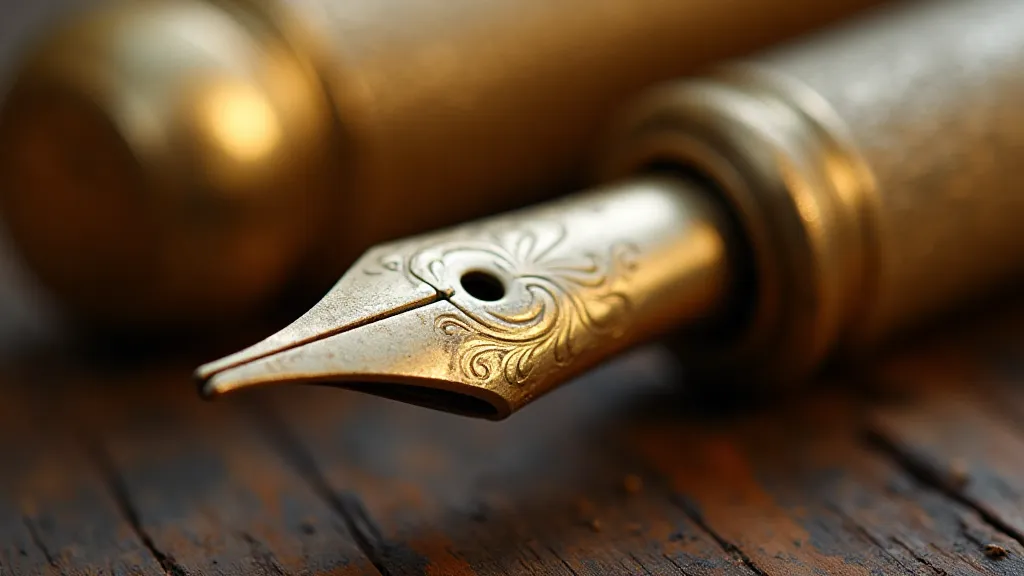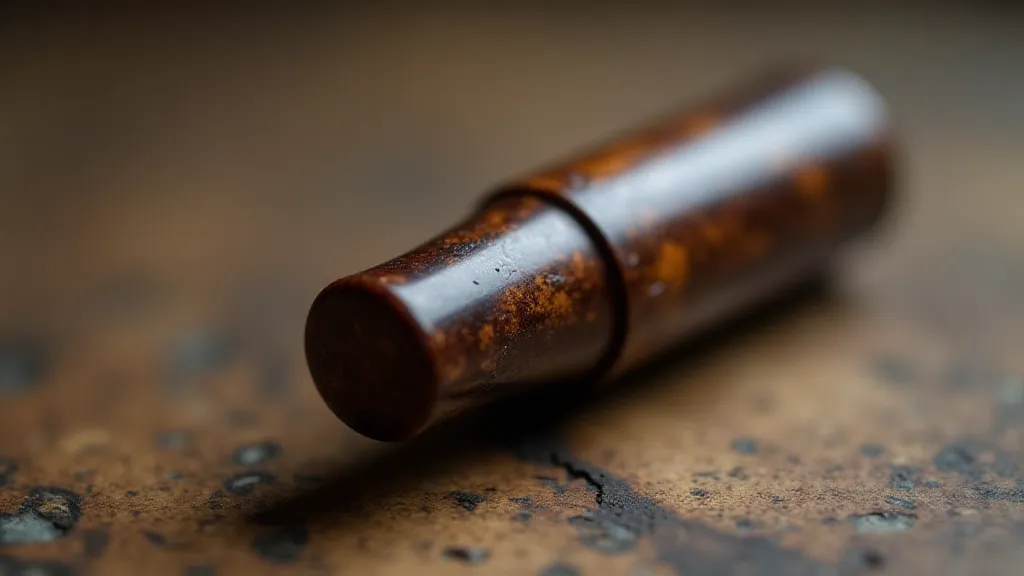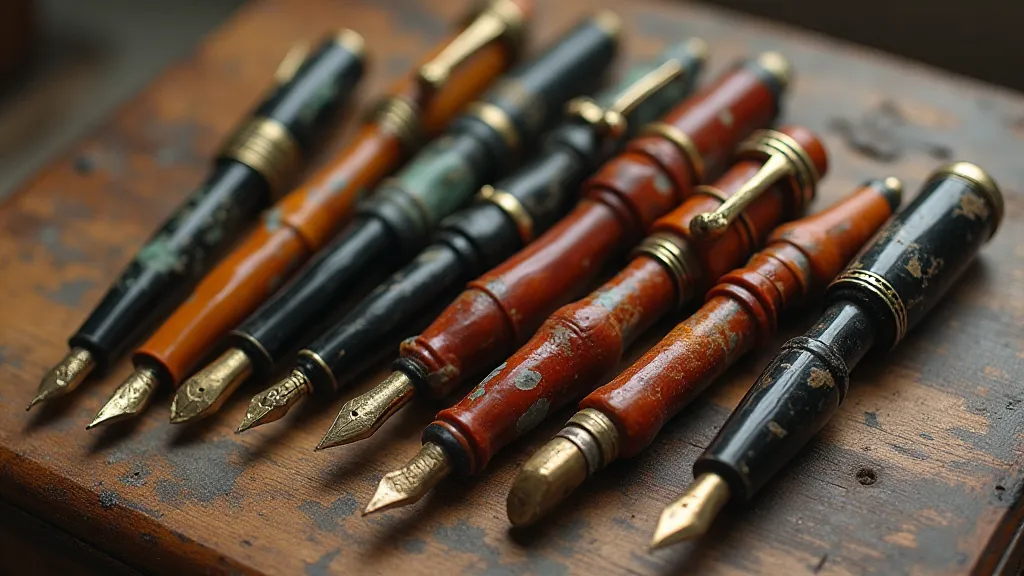The Resonance of Brass: A Deep Dive into Vintage Pen Materials
There’s a certain weight, a subtle vibration, when you hold a vintage fountain pen. It’s more than just the mass of the components; it’s the echo of time, of the materials themselves speaking across decades. These aren't disposable objects; they’ve lived through wars, witnessed history, and carried countless thoughts to paper. Understanding the materials that compose these writing instruments – brass, celluloid, ebonite, and more – isn't just a technical exercise; it’s a pathway to appreciating their enduring beauty and the remarkable craftsmanship that brought them into being.
My own journey into vintage pens began with a discarded Parker 51. My grandfather, a meticulous accountant, had passed away, and amongst his belongings was this tarnished beauty. I remember the feeling of the cool metal in my hand, the slight resistance of the piston mechanism. I didn’t understand then the materials' significance, but I felt a deep connection to him through this object. That simple pen sparked a lifelong fascination, leading me to a deeper understanding of the materials that define these treasured objects.
Brass: The Foundation of Strength and Beauty
Brass, an alloy of copper and zinc, formed the backbone of countless vintage pens. Its affordability and workability made it a popular choice for barrels, caps, and clips. The proportion of copper and zinc dictates the color, ranging from a deep reddish-gold to a paler, almost yellow hue. Early brass components often had a raw, utilitarian appearance, but as techniques improved, brass was lacquered or finished with other treatments to enhance its appearance and protect it from corrosion. A particularly lovely quality found in many vintage pens is "fire-engine red," a reddish-orange brass which, when polished, shines with a warm and captivating glow.

The appeal of brass extends beyond its aesthetics. It’s robust, durable, and lends a satisfying heft to the pen. However, brass is susceptible to oxidation, the infamous "green tarnish" that many collectors wrestle with. This isn's always a negative; a carefully preserved patina can indicate age and authenticity. But removing it requires careful techniques, knowledge of chemical reactions, and a healthy respect for the material – too aggressive cleaning can damage the underlying metal.
Celluloid: The Shimmering Miracle of Early Plastics
Before the prevalence of plastics as we know them, there was celluloid, often referred to as “early plastic.” Invented in the 1860s, it revolutionized pen manufacturing, allowing for a wider range of colors and patterns previously unattainable with brass. The manufacturing process was complex – nitrocellulose, camphor, and dyes were combined under intense pressure and heat. This gave celluloid its distinctive, swirling patterns and a beautiful, almost translucent quality. Colors ranged from deep blacks and reds to vibrant greens and blues. It’s particularly celebrated for the “swirls” and “chatoyancy” – a shimmering effect that changes with the angle of light.
Many prestigious pen manufacturers, including Waterman, Parker, and Montblanc, heavily utilized celluloid in their early models. The beauty of celluloid isn’t just superficial; its inherent complexity meant that each pen was truly unique – no two patterns were identical. Celluloid is also incredibly sensitive to heat and solvents. Decades of exposure to these elements can lead to cracking and brittleness. Careful storage and restoration are crucial for preserving these treasures.
Ebonite: The Resilience of Hard Rubber
Ebonite, or hard rubber, offered a different set of advantages. Made from vulcanized rubber – rubber heated with sulfur – it’s significantly harder and more durable than standard rubber. This made it ideal for components like pistons, sacs, and sometimes barrels and caps. Ebonite’s density gives it a pleasing weight and a satisfying feel in the hand. The color is typically a deep black, though variations exist, often caused by the addition of colorants during the vulcanization process.
The early days of fountain pen manufacturing saw many companies struggle with leaky pens, and the reliability of ebonite sacs was a crucial factor in improving pen performance. The material's resilience and impermeability made it an essential component in the pursuit of dependable writing instruments. Restoring ebonite sacs often requires specialized techniques and compatible replacement materials – a crucial skill for any serious vintage pen enthusiast.
Bakelite: A Durable Pioneer in Plastics
Bakelite, introduced in the early 1900s, marked another significant advancement in plastics. It was the first fully synthetic plastic, completely free of natural ingredients. Its durability and resistance to heat and chemicals made it suitable for a wider range of pen components than celluloid, including caps, barrels, and end caps. Bakelite’s characteristic qualities include a smooth, polished surface and a range of colors, often a deep brown, black, or amber. It's also notably strong and less prone to cracking than celluloid.
While the aesthetic appeal of Bakelite can be debated (some find its starkness less desirable than the swirling patterns of celluloid), its contribution to pen manufacturing and broader industrial applications is undeniable. Its relative ease of molding and its inherent strength made it an invaluable material for creating functional and affordable pens.

Beyond the Major Players
Of course, this isn’s an exhaustive list. Other materials, like acrylic, aluminum, and even precious metals (gold, silver) were utilized in vintage pens, each contributing to the diverse range of designs and aesthetics found across the collecting world. Each material brings a unique feel and a specific set of restoration challenges. Understanding these differences isn’t just about technical accuracy; it’s about appreciating the story each pen holds.
Holding a vintage pen is holding a piece of history. Recognizing the properties and significance of the materials that compose it – the shimmering celluloid, the resilient ebonite, the dependable brass – deepens our connection to these objects and allows us to appreciate the remarkable craftsmanship that created them. It’s an ongoing journey of discovery, a continuous unveiling of the resonance held within these beautiful instruments, a resonance that speaks volumes about the ingenuity and artistry of a bygone era.






